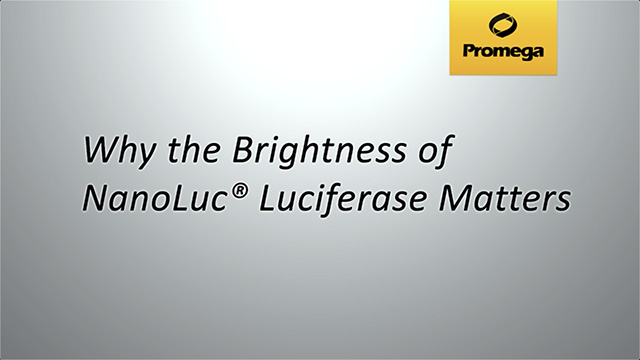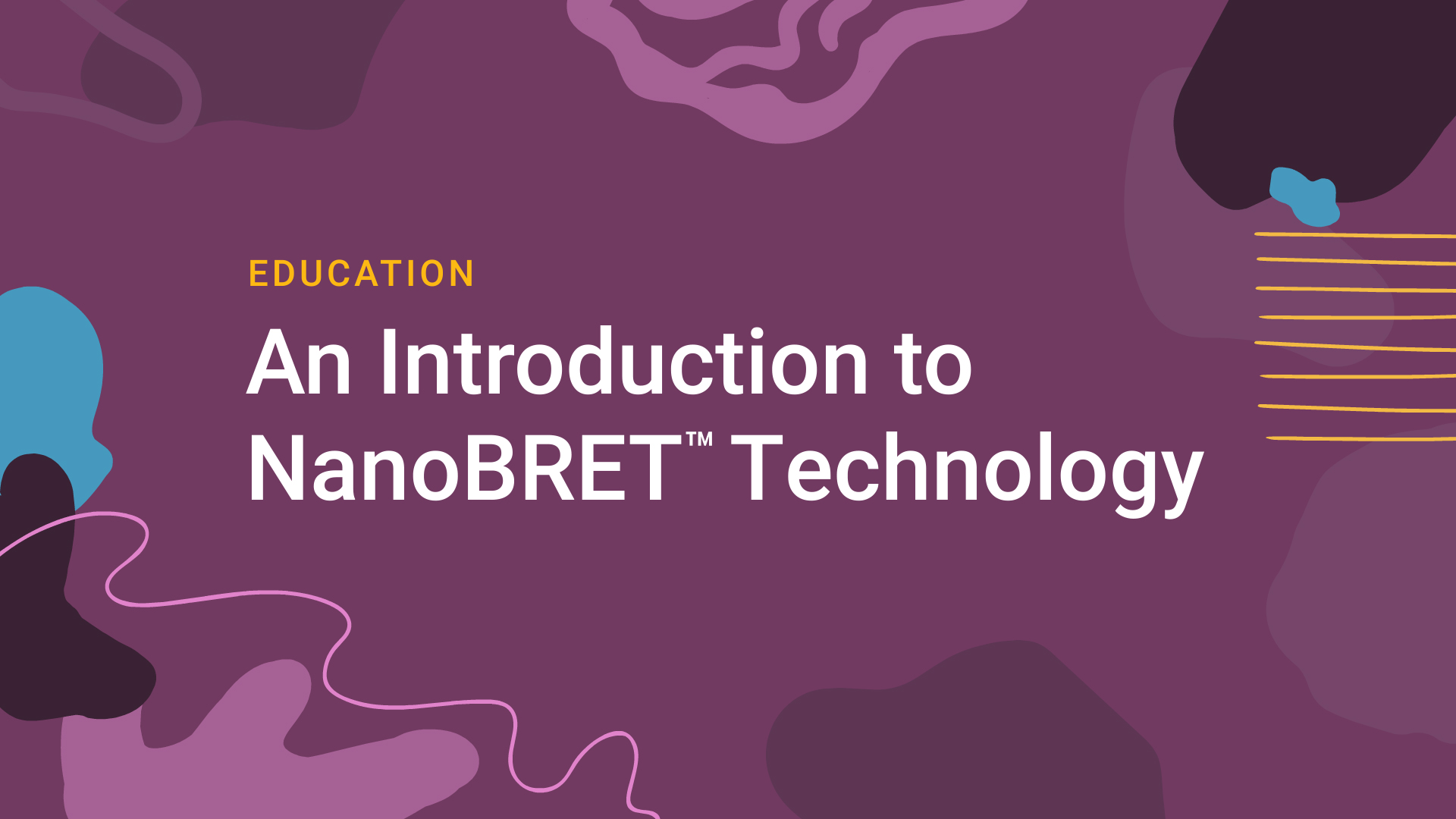NanoLuc® Luciferase
One Enzyme, Endless Capabilities
The small size and bright luminescence of NanoLuc® luciferase bring exquisite sensitivity to many applications. From NanoBRET® technology, a BRET-based method to study protein:protein and protein:small molecule interactions, to NanoLuc® Binary Technology (NanoBiT), NanoLuc is the cornerstone for studying genetic responses and protein dynamics in cells at physiologically relevant levels. The flexibility of NanoLuc® technologies provides you with the bioluminescent building blocks to understand biological interactions or perform compound screening in ways that have never been possible before.

NanoLuc® Luciferase
NanoLuc® luciferase is a small (19.1kDa), highly-stable enzyme derived from a deep-sea shrimp and engineered for optimal performance as a luminescent reporter. The enzyme is about 100-fold brighter than either firefly (Photinus pyralis) or Renilla reniformis luciferase using a novel substrate, furimazine, to produce high intensity, glow-type luminescence. The luminescent reaction is ATP-independent and designed to suppress background luminescence for maximal assay sensitivity. In addition to use as a traditional genetic reporter, the small size and extreme brightness of NanoLuc® luciferase make it an ideal protein fusion partner, expanding its utility to the study of live-cell protein dynamics.

A comparison of the sensitivity of NanoLuc®, firefly and Renilla luciferase assays.

Watch the video to learn more about NanoLuc® Luciferase technology.
Reporter Viruses
Explore viral biology with a small reporter that can be packaged without disrupting the virus you are studying.
Bioluminescence Imaging
Learn about using bioluminescence to image events in live cells and whole animals—no excitation required.
Genetic Reporters
Learn how NanoLuc® luciferase expands the possibilities of genetic reporter assays.
NanoBiT® Technology
NanoLuc® Binary Technology (NanoBiT) is a structural complementation reporter system based on NanoLuc® luciferase. It is composed of an optimized LgBiT subunit (18kDa) and a small 11 amino acid complimentary peptide subunit which can have varying affinities for LgBiT. The low affinity complimentary peptide is called SmBiT. For the study of cellular protein:protein interactions, the LgBiT and SmBiT subunits are expressed as fusions to target proteins of interest and expressed in cells. When the two proteins interact, the subunits come together to form an active NanoBiT® enzyme and generate a bright luminescent signal in the presence of Nano-Glo® substrate. This technology enables the study of real-time protein-protein interactions in live cells with high sensitivity and specificity.

Watch the video to learn more about NanoBiT® technology for studying protein:protein interactions.
The low affinity LgBiT and SmBiT subunits have been further adapted for immunodetection giving rise to Lumit® Immunoassays. In this configuration of NanoBiT® technology antibodies are chemically labeled with LgBiT and SmBiT subunits. When these labeled antibodies bind to the target analyte, SmBiT and LgBiT come into close proximity, forming the active NanoBiT® luciferase and generating a luminescent signal in the presence of Lumit® detection reagents. Lumit® Immunoassays offer a simple alternative to traditional ELISA assays with fewer wash steps and have been developed in direct, indirect, and competitive binding formats for a number of popular targets including cytokines and glucagon as well as DIY solutions.

Principle of Lumit® Immunoassays.
The LgBiT subunit can also be complemented by a high affinity small subunit called HiBiT to create the HiBiT Protein Tagging System. In this configuration of the technology, LgBiT and HiBiT spontaneously interact to reconstitute the bright NanoBiT® enzyme. HiBiT is used as a quantitative protein tag that can be introduced through traditional cloning methods or at endogenous loci through CRISPR-Cas9 gene editing. The HiBiT-tagged fusion protein can be detected using LgBiT-containing detection reagents, in live cells co-expressing the LgBiT subunit, or directly using a highly sensitive anti-HiBiT monoclonal antibody. The HiBiT protein tagging system is a simple and flexible protein detection option with high sensitivity to accurately detect even low abundance proteins at endogenous levels of expression.

Watch the video to learn more about HiBiT protein tagging.
Protein:Protein Interactions
Measure protein:protein interactions in real time at physiological expression levels.
HiBiT Protein Tagging
Detect and quantify any tagged protein with a variety of sensitive methods.
Lumit® Immunoassays
Bioluminescence-based detection of specific antigens or antibodies.
NanoBRET® Technology
NanoBRET® technology is a bioluminescence resonance energy transfer (BRET)-based method used to measure either protein:protein interactions or compound target engagement in live cells. NanoLuc® luciferase is an optimal BRET energy donor due to its bright signal and narrow, blue-shifted emission spectrum. For NanoBRET® Protein:Protein Interaction Assays, one protein partner is expressed as a NanoLuc® Luciferase fusion. The second protein is expressed as a HaloTag® fusion, which is labeled with a cell permeable NanoBRET® 618 fluorophore. The bright, blue-shifted donor signal and optimized red-shifted acceptor create optimal spectral overlap, resulting in increased signal and lower background compared to conventional BRET assays. Predesigned assays for a number of popular targets, DIY systems, and custom NanoBRET® PPI development services are available.

NanoBRET® technology can also be applied for live-cell compound binding assays, referred to as NanoBRET® Target Engagement (TE). In this assay format, the target protein is expressed in cells as a NanoLuc® luciferase fusion. A cell-permeable fluorescent NanoBRET® tracer, which reversibly binds to the target protein, is added. Fluorescent tracer binding to the NanoLuc® fusion protein results in energy transfer and a BRET signal. Test compounds that bind to the target protein compete with the tracer and result in loss of NanoBRET® signal enabling quantitative measurement of intracellular compound affinity. NanoBRET® TE can also be used to calculate fractional occupancy, compound selectivity, intracellular compound availability and compound residence time. Recent configurations of NanoBRET® TE use reconstituted NanoBiT® luciferase as the energy donor, enabling the study of target engagement on intracellular protein complexes. Pre-designed assays are available for a number of key drug targets, including 340+ kinases. DIY tools, and custom development and cellular kinase selectivity profiling services are also available.

NanoBRET® PPI assay principle.

NanoBRET® TE assay principle.
Protein:Protein Interactions
Measure protein:protein interactions in real time at physiological expression levels.
Target Engagement
Quantitatively measure target occupancy, compound affinity, residence time and permeability in live cells.
RAS Pathway Drug Discovery
Explore assays and technologies to facilitate RAS drug discovery.